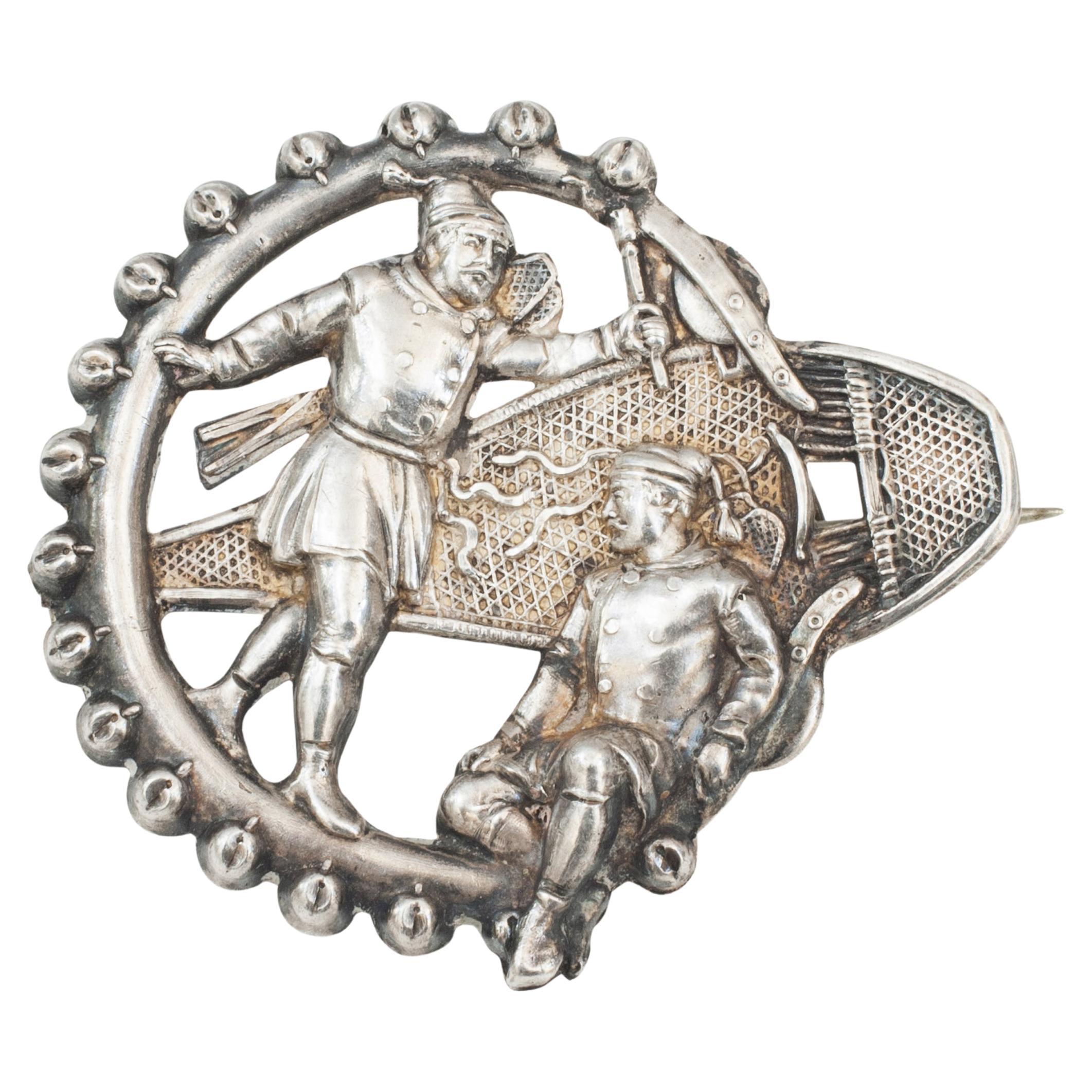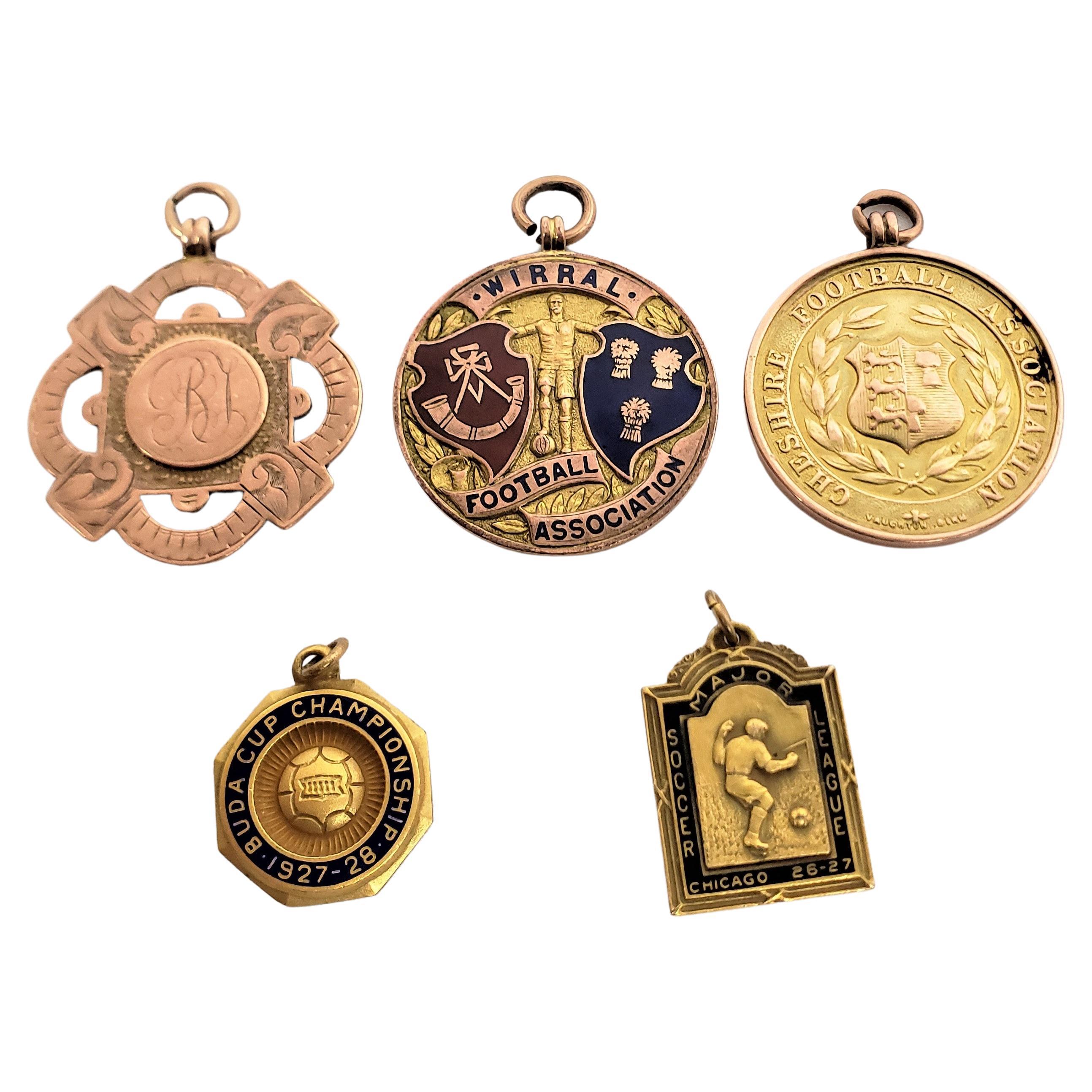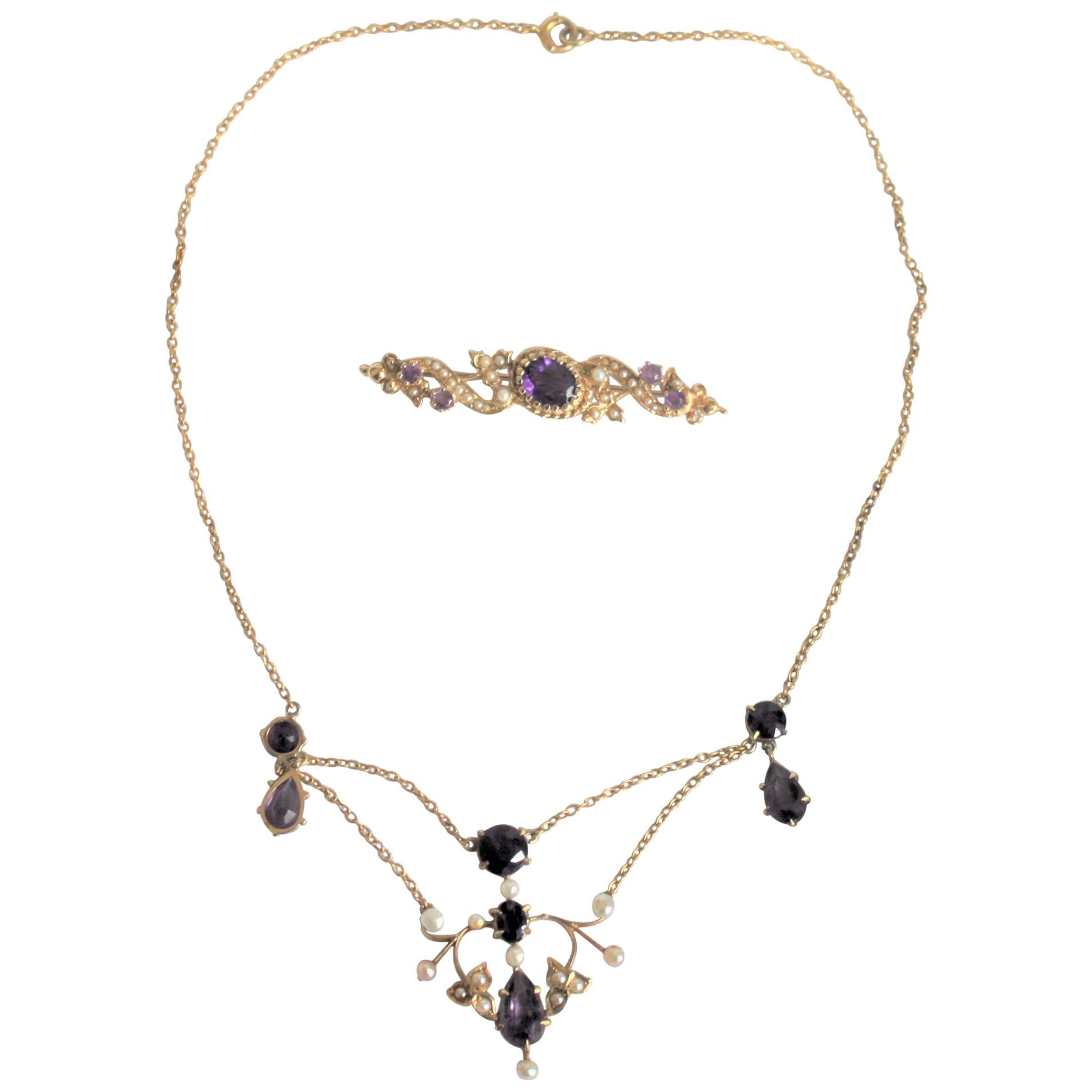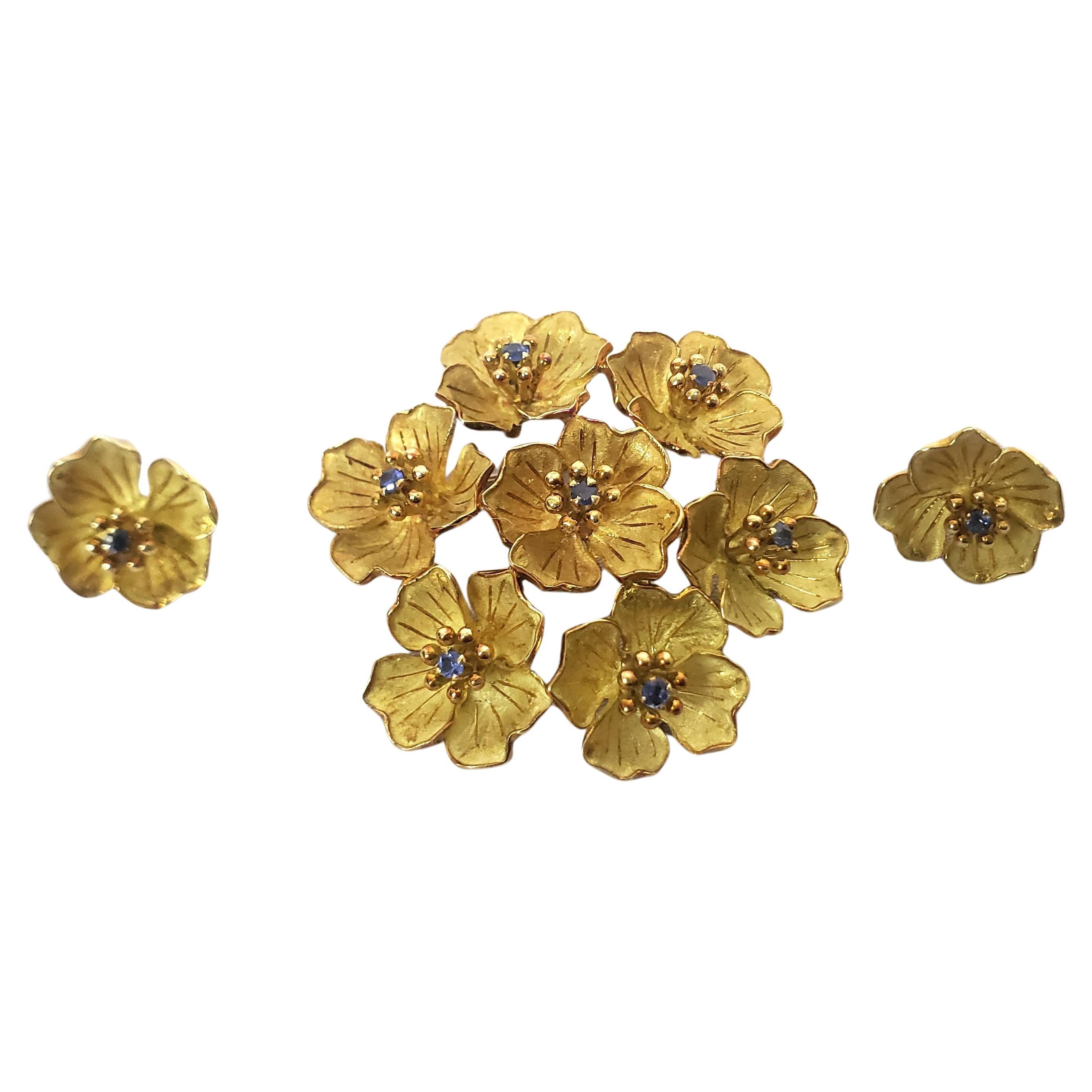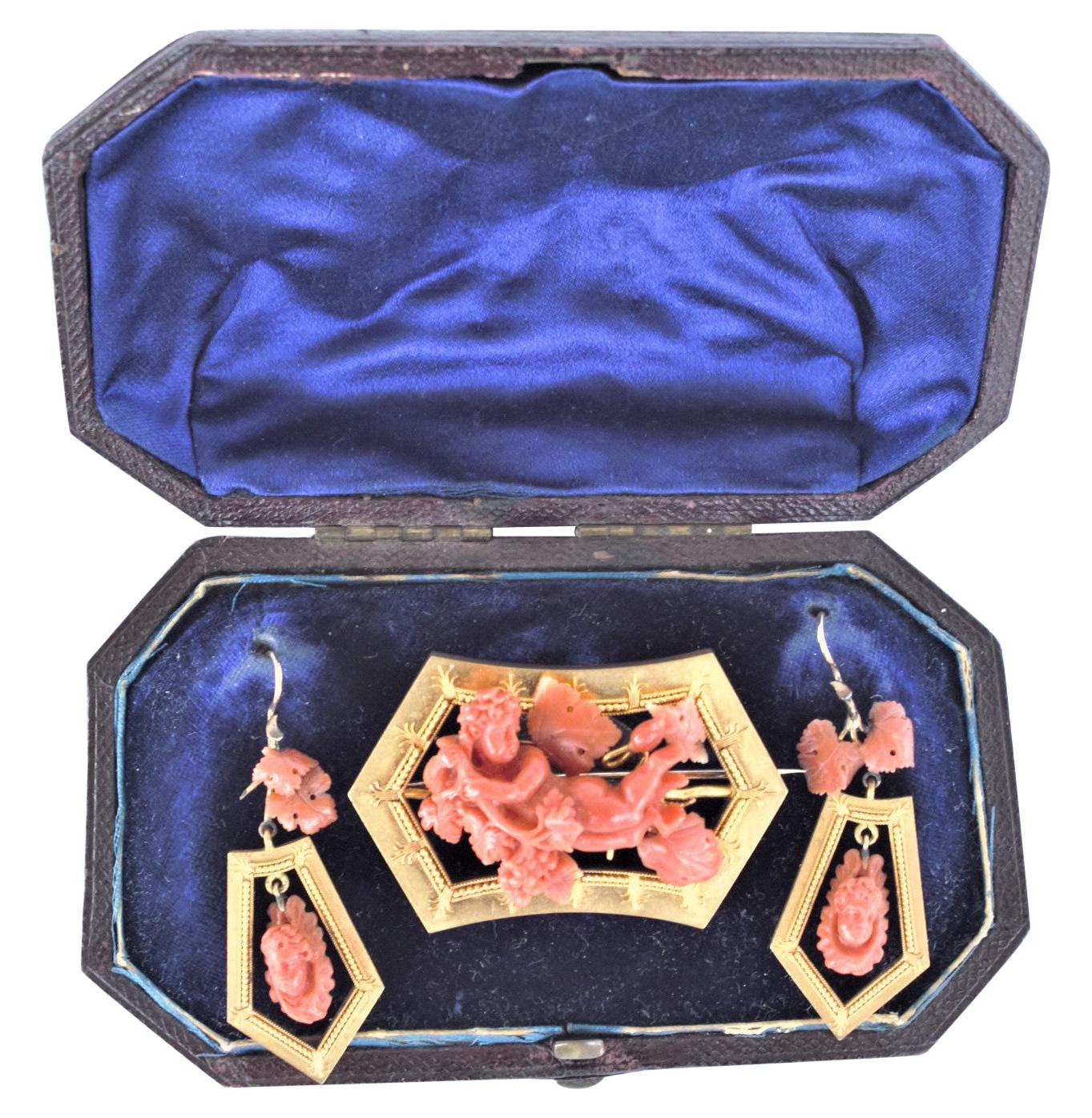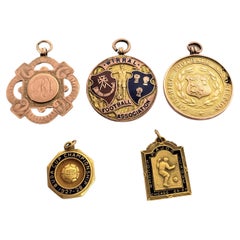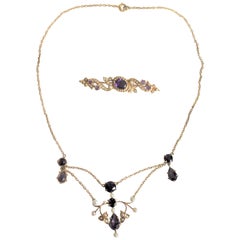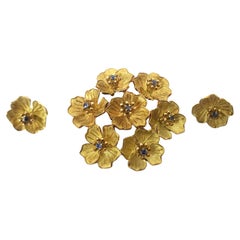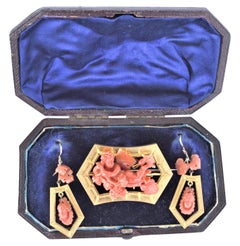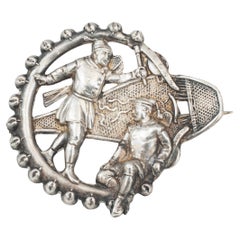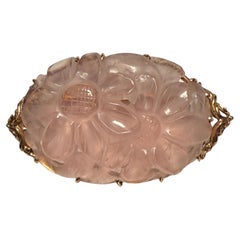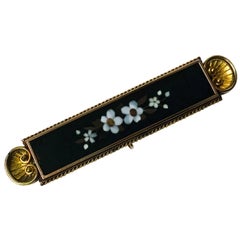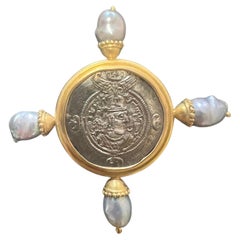Items Similar to Antique English Horse Jumping or Steeplechase 9 Karat Yellow Gold Brooch or Pin
Want more images or videos?
Request additional images or videos from the seller
1 of 13
Antique English Horse Jumping or Steeplechase 9 Karat Yellow Gold Brooch or Pin
About the Item
This antique brooch or pin is unsigned, but presumed to have originated from England and date to approximately 1900 and done in the period Edwardian style. The pin is composed of nine karat yellow gold with a glass medallion in the center portraying a man dressed in classic period attire mounted on a jumping horse. The medallion is hand-crafted and either reverse painted, or enameled and mounted to the bezel. The bezel is marked on the back for nine karat gold, with possibly the maker's initial.
- Dimensions:Height: 0.5 in (1.27 cm)Width: 2.25 in (5.72 cm)Depth: 0.38 in (9.66 mm)
- Style:Edwardian (Of the Period)
- Materials and Techniques:
- Place of Origin:
- Period:
- Date of Manufacture:1900
- Condition:Wear consistent with age and use. Some light surface wear as presented in the photos, and consistent with age and use.
- Seller Location:Hamilton, CA
- Reference Number:1stDibs: LU1355230479262
About the Seller
5.0
Platinum Seller
Premium sellers with a 4.7+ rating and 24-hour response times
Established in 2010
1stDibs seller since 2015
1,316 sales on 1stDibs
Typical response time: 1 hour
- ShippingRetrieving quote...Shipping from: Hamilton, Canada
- Return Policy
Authenticity Guarantee
In the unlikely event there’s an issue with an item’s authenticity, contact us within 1 year for a full refund. DetailsMoney-Back Guarantee
If your item is not as described, is damaged in transit, or does not arrive, contact us within 7 days for a full refund. Details24-Hour Cancellation
You have a 24-hour grace period in which to reconsider your purchase, with no questions asked.Vetted Professional Sellers
Our world-class sellers must adhere to strict standards for service and quality, maintaining the integrity of our listings.Price-Match Guarantee
If you find that a seller listed the same item for a lower price elsewhere, we’ll match it.Trusted Global Delivery
Our best-in-class carrier network provides specialized shipping options worldwide, including custom delivery.More From This Seller
View AllAntique English Nine Karat Yellow Gold Football or Soccer Medals & Two Plated
Located in Hamilton, Ontario
This group of antique English football medals are sugned by an unknown maker, and date to approximately 1914 and done in the period Georgie V style. The three larger medals are each ...
Category
Early 20th Century English Georgian Sports Equipment and Memorabilia
Materials
Gold
Antique 14-Karat Yellow Gold, Amethyst and Seed Pearl Necklace and Brooch
Located in Hamilton, Ontario
This antique pairing of a yellow 14-karat gold necklace and brooch are presumed to have been made in the United States in circa 1910 in the period Edwardian style. Both pieces are co...
Category
Early 20th Century American Edwardian Collectible Jewelry
Materials
Gold
Antique Italian 18 Karat Yellow Gold & Saphire Floral Brooch & Earrings Set
Located in Hamilton, Ontario
This antique brooch and earrings set originates from Italy and dates to approximately 1920 and done in the period Art Deco style. The bod...
Category
Early 20th Century Italian Art Deco Collectible Jewelry
Materials
Gold
Antique Ladies Carved Coral Cherub & 14-Karat Yellow Gold Brooch & Earrings Set
Located in Hamilton, Ontario
This antique demi-parure set is completely unmarked but tests for a minimum of 14-karat yellow gold and is believed to have been made in England in circa 1890 in the period Victorian...
Category
Antique Late 19th Century English Late Victorian Collectible Jewelry
Materials
Coral, Gold
14-Karat Yellow Gold with Agate & Claw Set Citrine Quartz Brooch or Pendant
Located in Hamilton, Ontario
Presumed to be a Victorian brooch with a contemporary assay mark, this artisan made 14- karat yellow gold disc shaped pendant pin is heavily engraved and combined with an agate surro...
Category
Antique Late 19th Century English Victorian Collectible Jewelry
Materials
Gold
Antique Miniature Portrait on Bone with Fitted Case 14-Karat Yellow Gold Brooch
Located in Hamilton, Ontario
Dating from the late 17th century and done in the Federalist style, this finely detailed and well executed hand painted miniature portrait on bone of a period nobleman can be worn as...
Category
Antique Late 17th Century American Federal Collectible Jewelry
Materials
Gold
You May Also Like
Antique Snowshoe Brooch Or Pin. Wintersport.
Located in Oxfordshire, GB
Snowshoe Brooch Or Pin.
A very nice piece of antique winter themed jewellery, a broach in the form of a snowshoe with two gentlemen. The surround is in the form of a leather strand w...
Category
Early 20th Century Scandinavian Sporting Art Sports Equipment and Memora...
Materials
Silver
Antique Carved Rose Quartz 14K Gold Pin Brooch
Located in Norwood, NJ
Fine quality hand carved oval rose quartz pin brooch set in a 14K yellow gold frame. This is a vintage piece of estate jewelry circa 1910. The frame is an elegant thin oval setting w...
Category
Early 20th Century French Collectible Jewelry
Materials
Gold
Antique Pietra Dura Brooch Pin, Italy, circa 1875
Located in Toronto, Ontario
Gold Pietra Dura brooch pin, Italy, circa 1875. The elongated shape, fine Pietra Dura floral white and green flower inlay colors, the surround gold ...
Category
Antique 19th Century Collectible Jewelry
Materials
Gold
$920 Sale Price
20% Off
Elizabeth Locke Silver Saanian Roman Coin Sea Pearl 18k Gold Frame Pin or Brooch
Located in Plainview, NY
An exquisite Silver Sasanian Coin Depicting Xusro I ( circa 300AD) with Baroque South Sea Pearls in an 18K Gold Frame Brooch or Pin by the legendary jewelry designer Elizabeth Locke....
Category
20th Century Baroque Collectible Jewelry
Materials
Gold
$7,840 Sale Price
20% Off
Rare 19th Century English Tunbridgeware Hair Pin or Slide
Located in Dallas, TX
Presenting an absolutely gorgeous and extremely unique and rare 19th century British Tunbridgeware hair pin/bobbin or slide.
This slide is unlike any of it’s kind we have seen before…. it is a very rare survivor !
From circa 1860–1880.
Made of walnut with gorgeous marquetry inlay on the entirety of the front with classic Tunbridgeware micro-mosaic all over the front. The rear is walnut.
The marquetry inlay appears to be various different woods, namely, maple, walnut and satinwood.
Would have been worn in a Lady’s hair bun with the micro-mosaic facing forward.
This would have belonged to a very elegant lady in the mid to late 19th century.
Tunbridge ware is a form of decoratively inlaid woodwork, typically in the form of boxes, that is characteristic of Tonbridge and the spa town of Royal Tunbridge Wells in Kent in the 18th and 19th centuries. The decoration typically consists of a mosaic of many very small pieces of different coloured woods that form a pictorial vignette. Shaped rods and slivers of wood were first carefully glued together, then cut into many thin slices of identical pictorial veneer with a fine saw. Elaborately striped and feathered bandings for framing were pre-formed in a similar fashion.
There is a collection of Tunbridge ware in the Tunbridge Wells Museum and Art Gallery in Tunbridge Wells.
The famous makers of Tunbridge ware were in the Tunbridge Wells area of Kent; their most notable work was from circa 1830-1900.
Early makers of Tunbridge ware, in Tunbridge Wells in the mid-18th century, were the Burrows family, and Fenner and Co. In the 19th century, around 1830, James Burrows invented a technique of creating mosaics from wooden tesserae. Henry Hollamby, apprenticed to the Burrows family, set up on his own in 1842 and became an important manufacturer of Tunbridge ware, employing about 40 people.
Edmund Nye (1797–1863) and his father took over the Fenner company when William Fenner retired in 1840, after 30 years in partnership with him. Thomas Barton (1819–1903), previously apprenticed at the Wise factory, joined the Nyes in 1836, and worked as Nye’s designer; he took over the business in 1863 and continued there until his death.
In Tonbridge (near to Tunbridge Wells), George Wise (1703–1779) is known to have had a business in 1746. It continued with his son Thomas, and Thomas’s nephew George (1779–1869), who took over in 1806. In its early years the company made articles such as workboxes and tea caddies with prints of popular views; later items had pictures created from mosaics. Their workshop in Tonbridge, Wise’s Tunbridge Ware Manufactory, was next to the Big Bridge over the Medway; the building was demolished in 1886 to widen the approach to the bridge.
Tunbridge ware became popular with visitors to the spa town of Tunbridge Wells, who bought them as souvenirs and gifts. Articles included cribbage boards, paperweights, writing slopes, snuffboxes and glove boxes.
At the Great Exhibition of 1851, Tunbridge ware by Edmund Nye, Robert Russell and Henry Hollamby was shown; Edmund Nye received a commendation from the judges for his work. He exhibited a table depicting a mosaic of a ship at sea; 110,800 tesserae were used in making the picture.
The manufacturers of Tunbridge ware were cottage industries, and they were no more than nine in Tunbridge Wells and one in Tonbridge. The number declined in the 1880s; competent craftsmen were hard to find, and public tastes changed. After the death of Thomas Barton in 1903 the only surviving firm was Boyce, Brown and Kemp, which closed in 1927.
Marquetry was an old technique which was continued by Nye and Barton to create images such as birds or butterflies.
‘Green Oak’ as caused by the fungus Chlorociboria aeruginascens.
Stickware and half-square mosaic was invented by James Burrows in about 1830: a bunch of wooden sticks of different colours, each having triangular or diamond-shaped cross section, were tightly glued together; in the case of stickware, the resulting block was dried, then turned to form an article such as the base of a pincushion. For half-square mosaic, thin slices were taken from the composite block, and applied to a surface.[1][2][4]
Tesselated mosaic, was a development by James Burrows of half-square mosaic; it was adopted by George Wise and Edmund Nye. Minute tesserae were used to form a wide variety of geometric and pictorial designs.
Many sorts of wood were used for the various colours; about 40 were in regular use. Only natural colors were used; green was provided by “green oak”, produced by the action of fungus on fallen oak. Designs for articles were often taken from designs of Berlin wool work.
Category
Antique Late 19th Century English High Victorian Collectible Jewelry
Materials
Satinwood, Walnut
Two Antique German Art Nouveau Jewelry Memory Pin Brooch Ormolu, 1900s
Located in Nuernberg, DE
Two lovely stylish sentimental brooches made to keep a photo of loved one. Made in Germany, circa 1900. Each brooch pin has a picture inside.
A very pretty piece of antique jeweller...
Category
Antique Early 1900s German Art Nouveau Collectible Jewelry
Materials
Ormolu
Recently Viewed
View AllMore Ways To Browse
Nine Karat Gold
Antique Horse Jewellery
Horse Pin
Horse Pins
Antique Gold Medallion Jewlery
Gold Horse Pin
Antique Hand Painted Brooches
Initial Pins
Horse Brooch Pin
Enamel On Glass Brooches
Horse Medallion
Edwardian Gold Dress
Edwardian Horse
Medallion Brooch
France And Sons Side Table
French Chrome And Glass Coffee Table
French Wall Mount Console
Glass Dish Orange
